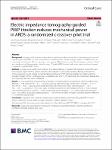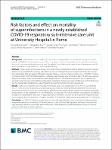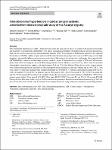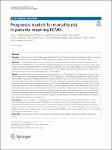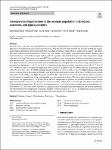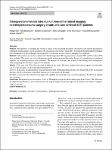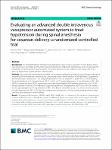Search
Author
- Daqing, Ma (3)
- Alexis, Ferré (2)
- Anna, Lybeck (2)
- Ashish K., Khanna (2)
- next >
Subject
- intensive care unit (8)
- acute respiratory dist... (5)
- chronic obstructive pu... (5)
- ICU (5)
- next >
Date issued
Has File(s)
Search Results
In patients with acute respiratory distress syndrome undergoing mechanical ventilation, positive end-expiratory pressure (PEEP) can lead to recruitment or overdistension. Current strategies utilized for PEEP titration do not permit the distinction. Electric impedance tomography (EIT) detects and quantifies the presence of both collapse and overdistension. We investigated whether using EIT-guided PEEP titration leads to decreased mechanical power compared to high-PEEP/FiO2 tables. |
Cardiac herniation has been reported in thoracic trauma and after pneumonectomy; however, it is sporadic in cardiac surgery. |
Little is known on the burden of co-infections and superinfections in a specific setting such as the respiratory COVID-19 sub-intensive care unit. This study aims to (i) assess the prevalence of concurrent and superinfections in a respiratory sub-intensive care unit, (ii) evaluate the risk factors for superinfections development and (iii) assess the impact of superinfections on in-hospital mortality. |
Supporting the provision of intensive care medicine through telehealth potentially improves process quality. This may improve patient recovery and long-term outcomes. We investigated the effectiveness of a multifaceted telemedical programme on the adherence to German quality indicators (QIs) in a regional network of intensive care units (ICUs) in Germany. |
Esmolol as one treatment of sepsis induced cardiomyopathy (SIC) is still controversial. The objective of this study is to evaluate cardiac function after reducing heart rate by Esmolol in patients with SIC using speck-tracking echocardiography. |
Intra-abdominal hypertension (IAH) is frequently present in the critically ill and is associated with increased morbidity and mortality. Conventionally, intermittent ‘spot-check’ manual measurements of bladder pressure in those perceived as high risk are used as surrogates for intra-abdominal pressure (IAP). True patterns of IAH remain unknown. We explored the incidence of IAH in cardiac surgery patients and describe the intra-and postoperative course of IAP using a novel, high frequency, automated bladder pressure measurement system. |
To provide an overview and evaluate the performance of mortality prediction models for patients requiring extracorporeal membrane oxygenation (ECMO) support for refractory cardiocirculatory or respiratory failure. |
The risk factors, outcomes, and typical patterns of intraoperative hypothermia were studied in neonates to better guide the application of insulation measures in the operating room. This retrospective study enrolled 401 neonates undergoing surgery under general anaesthesia with tracheal intubation, including abdominal surgery, thoracic surgery, brain surgery, and others. The study collected basic characteristics, such as age, sex, weight, birth weight, gestational week, primary diagnosis and American Society of Anaesthesiologists (ASA) grade. |
Intraoperative 3D imaging has become a valued tool in assessing the quality of reduction and implant placement in orthopedic trauma surgery. In our institution, 3D imaging is used routinely since 2001. To evaluate the intraoperative findings and consequences of this technique, intraoperative revision rates in cases with 3D imaging were analyzed. |
The optimal treatment of hypotension during spinal anaesthesia is uncertain. A novel double intravenous vasopressor automated (DIVA) system reduces hypotension compared to standard care, and was subsequently modified to an advanced-DIVA (ADIVA) system. The primary objective was to compare ADIVA versus DIVA on incidence of hypotension (systolic BP (SBP) < 80% baseline). |

